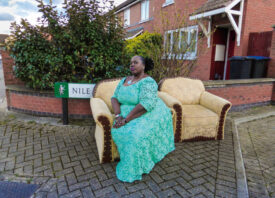Search this site
Step Inside Mexico City’s Historic Danzòn Ballrooms


On one Sunday evening in January 2020, while visiting Mexico City, the photographer Chiara Bonetti entered Salon Los Angeles, a ballroom dating back to 1937, at the invitation of a friend. The moment she walked onto the black-and-white checkered floor, elegant Danzón melodies filling her ears, she knew she’d found something special. “At the time, I had no clue about Danzòn music and the Cuban scene in the city, but it was like love at first sight,” she remembers.
Soon after, she postponed her flight out of Mexico City, determined to spend more time at Salon Los Angeles and historic clubs like it. Her friend Karina helped introduce her to some of the regulars at the club, and she was soon welcomed into a community of dancers dating back decades. “At the beginning of the 20th century, Danzón was transported to Mexico, first to Veracruz and then quickly around the country,” the photographer explains.
“It steadily became very popular–and somewhat controversial. The arousing tempo; the racy, swaying dance steps; the proximity between dance partners; and the women fanning themselves seductively were very provocative at the time. Today, it seems incredible to think that these clubs and their communities have existed in the same places for more than eighty years. As you enter, it seems as if nothing has changed–like a journey back in time.”
That first night at Salon Los Angeles, Bonetti was surprised and delighted to be announced on stage as the club’s official photographer. Later, she’d discover two more clubs: El Romo and El California. Over the next few weeks, she’d take up dancing herself, under the tutelage of Mario, a stylish man decked out in colorful zoot suits and fancy watch chains.
“Mario says that he is one of the last real Pachucos, part of a subculture created by Mexicans who emigrated to North American society in the decade between the 1930s and ’40s,” Bonetti explains. “Feeling deprived of their identity and importance in their adopted society, they invented a style, a music, and a dance that identified them.” Even today, people like Mario continue that legacy; “He feels like an outsider, a free man, a non-conformist,” the photographer says.
Bonetti splits her time between Berlin and Italy, but in some essential sense, visiting these Mexico City ballrooms felt like a homecoming. “I was miles away from the place of my birth, and my history and culture were indeed different, but there was a sense of familiarity,” she tells me. “These are places full of memories and wisdom from the older generations. It was only later that I connected my time in Mexico to my memories and childhood, when I spent most of my time playing cards and drawing with my great uncles or harvesting grapes and watching soap operas with my grandmother.”
Like playing cards and grape harvesting, dancing could be passed from one generation to the next. At Salon Los Angeles, Bonetti met Gloria, a woman who’s been dancing with her son Omar on Sundays for more than thirty years. “This is the space where she can express herself without limits, safely in the arms of her son,” the photographer says. “It is through dance, in fact, that she has been able to find herself again and regain her independence after the death of her husband and the raising of her children.”
Though she always remained within reach of the camera, Bonetti too hit the dance floor on occasion. “I had several dance masters, and it wasn’t easy at all, especially for me, since I am used to techno music and dancing in Berlin,” she explains. “But everyone can dance on the dance floor: from the experienced dancer to the curious and inexperienced one, like me.
“I’ve found a kind of magical moment occurs when you forget about differences in age, origin, or social class. I think that having fixed dance steps and basic patterns to follow makes this dance more of a collective ritual to which everyone feels they belong. Dance becomes communication. It is a vehicle for rediscovering the body, an escape channel, and, above all, a social link.”
For years and years, these ballrooms have remained open to veterans and newcomers alike, with regulars planning their outfits and coordinating with partners days in advance, but things shifted in March 2020, amid the COVID-19 pandemic. “For the first time in decades, the halls temporarily closed,” Bonetti says. “As they do not receive financial support from the government, these clubs are facing a huge crisis. They might be forced to close forever. Apart from being a great loss for the community that revolves around these salons, this would also be a huge loss for the history of the country itself.”
About a year after her visit in 2020, the photographer released a book project dedicated to the community, titled One Last Danzón. All of the proceeds from book sales went to Salon Los Angeles’s fundraising efforts, and beyond that, the book itself has served as a living testament to the people who’ve danced in these halls, the unmistakable clothes they wore, and the lifelong friendships they’ve forged. “I think the people in the book are proud to be able to show their passion, their beauty, and their talent,” she tells me. “At such a historical moment, I believe that it is even more important than ever for them to share their memories and keep these stories alive.”
One Last Danzón is currently sold out, but a second edition is forthcoming. You can shop prints from the project here. 20% of the proceeds from print sales will go to Salon Los Angeles.











